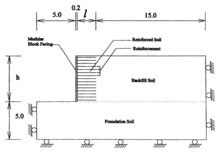- Mechanically stabilized earth
-
Mechanically stabilized earth or MSE is soil constructed with artificial reinforcing. It can be used for retaining walls, bridge abutments, dams, seawalls, and dikes.[1][2] Although the basic principles of MSE has been used throughout history, MSE was developed in its current form in the 1960s. The reinforcing elements used can vary but include steel and geosynthetics.
History
Using straw, sticks, and branches to reinforce adobe bricks and mud dwellings has happened since the earliest part of human history, and in the 16th and 17th centuries, French engineers used sticks to reinforce dikes. Reinforcing levees with branches has been done in China for at least a thousand years, and other reinforcements have been universally used to prevent soil erosion. Modern use of soil reinforcing for retaining wall construction was pioneered by French architect and engineer Henri Vidal in the 1960s. The first MSE wall in the United States was built in 1971 on State Route 39 near Los Angeles. It is estimated that since 1997, approximately 23,000 MSE walls have been constructed in the world. The highest MSE wall built in the United States is 30 m (98 ft) high.[3]
Reinforcement
The reinforcement materials of MSE can vary. Originally, long steel strips 50 to 120 mm (2 to 5 in) wide were used as reinforcement. These strips are sometimes ribbed, although not always, to provide added friction. Sometimes steel grids or meshes are also used as reinforcement. Several types of geosynthetics can be used including geogrids and geotextiles. The reinforcing geosynthetics can be made of high density polyethylene, polyester, and polypropylene. These materials may be ribbed and are available in various sizes and strengths.[3]
References
- ^ "Mechanically Stabilized Earth Structures". http://tc17.poly.edu/mse.htm. Retrieved 2007-01-27.
- ^ "Mechanically Stabilized Earth Wall Inspector's Handbook". Florida Department of Transportation. http://www.dot.state.fl.us/structures/Manuals/mse.pdf. Retrieved 2007-01-27.
- ^ a b "Mechanically Stabilized Earth Walls And Reinforced Soil Slopes: Design & Construction Guidelines". FHWA. (March 2001). http://isddc.dot.gov/OLPFiles/FHWA/010567.pdf. Retrieved 2007-08-27.
Topics in geotechnical engineering Soils Soil properties Soil mechanics Geotechnical investigation Laboratory tests Field tests Foundations Bearing capacity · Shallow foundation · Deep foundation · Dynamic load testing · Pile integrity test · Wave equation analysis · Statnamic load testRetaining walls Slope stability Earthquakes Geosynthetics Instrumentation for Stability Monitoring Categories:
Wikimedia Foundation. 2010.

